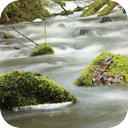(short preview of full seamless looping track)
(short preview of full seamless looping track)
(short preview of full seamless looping track)
(short preview of full seamless looping track)
(short preview of full seamless looping track)
Mud And Rocks River
This product is not available in the selected currency.
In Stock
Backordered
Out of Stock
Description
The summer day sucks upon nature's nipple, the river, drawing in every ounce of clear and clean water as it carries the world's nutrients downstream, attempting to feed every open mouth in the land. Creatures big and small that pass this way will bow their heads and be humbled by the simplicity and power of a fluid so delicate and unpretentious that it does not even have a color. You too know your place in this world, and you dip your toe into the flow, thanking the heavens for every drop they let go of. Rivers are often managed or controlled to make them more useful, or less disruptive, to human activity. Dams or weirs may be built to control the flow, store water, or extract energy. Levees, known as dikes in Europe, may be built to prevent river water from flowing on floodplains or floodways. Canals connect rivers to one another for water transfer or navigation. River courses may be modified to improve navigation, or straightened to increase the flow rate. River management is a continuous activity as rivers tend to 'undo' the modifications made by people. Dredged channels silt up, sluice mechanisms deteriorate with age, levees and dams may suffer seepage or catastrophic failure. The benefits sought through managing rivers may often be offset by the social and economic costs of mitigating the bad effects of such management. As an example, in parts of the developed world, rivers have been confined within channels to free up flat flood-plain land for development. Floods can inundate such development at high financial cost and often with loss of life.
Opps
Sorry, it looks like some products are not available in selected quantity.



